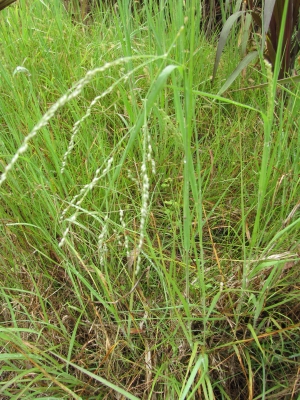Panicum coloratum
L.
Poaceae
Milium coloratum (L.) Moench
Panicum bossii Tropea
Panicum crassipes Mez
Panicum jainii Karthik. & Sundararagh.
Panicum nehruense Jauhar & Joshi
Panicum simpliciflorum Jauhar & Joshi
Panicum subalbidum tuberculosum Chiov.
Panicum swynnertonii Rendle
Common Name:



Flowering plant
Photograph by: USDA NRCS James E. "Bud" Smith Plant Materials Center
Public domain
General Information
Panicum coloratum is a very variable, perennial, clump-forming grass with erect culms growing 15 - 150cm tall.
The plant is sometimes used in soil stabilization projects.
Known Hazards
None known
Botanical References
Range
Africa - Cameroon, Egypt, Sudan, Ethiopia, Somalia, Uganda, Kenya, Tanzania, Angola, Zambia, Malawi, Mozambique, south to S. Africa.
Habitat
Grassland, open woodland, river beds, drainage courses, around pans or in depressions at elevations from sea level to 2,100 metres[
]. Often found on seasonally inundated soils[
415- Title
- Tropical Forages
- Publication
-
- Author
-
- Website
- http://www.tropicalforages.info/key/Forages/Media/Html/index.htm
- Publisher
-
- Year
- 0
- ISBN
-
- Description
- Mainly focussed on forage plants, the site gives a lot of information on the plant, with a good botanical description, details of cultivation, plant uses and a good selection of photographs.
].
Properties
| Other Uses Rating |      |
| Habit | Perennial |
| Height | 1.00 m |
| Pollinators | Wind |
| Cultivation Status | Cultivated |
Cultivation Details
A plant of the tropics and subtropics, where it is found at elevations up to 2,100 metres. It grows best in areas where annual daytime temperatures are within the range 17 - 26°c, but can tolerate 8 - 35°c[
]. When dormant, the plant can survive temperatures down to about -10°c, but young growth can be severely damaged at -1°c[
]. The plant is susceptible to frost but usually recovers[
]. It prefers a mean annual rainfall in the range 500 - 1,700mm, but tolerates 400 - 2,600mm[
].
Requires a sunny position[
]. Succeeds in most reasonably fertile soils[
]. Tolerant of saline soils[
]. Prefers a pH in the range 5.5 - 6.5, tolerating 5 - 7.5[
]. It is drought tolerant by virtue of its deep fibrous root system, and is able to grow on flood plains (where soil moisture is comparatively long-lasting)[
].
The plant is able to survive annual burning[
415- Title
- Tropical Forages
- Publication
-
- Author
-
- Website
- http://www.tropicalforages.info/key/Forages/Media/Html/index.htm
- Publisher
-
- Year
- 0
- ISBN
-
- Description
- Mainly focussed on forage plants, the site gives a lot of information on the plant, with a good botanical description, details of cultivation, plant uses and a good selection of photographs.
].
Panicum coloratum is generally slow to establish, competing relatively poorly with weeds and other pasture species during early growth[
415- Title
- Tropical Forages
- Publication
-
- Author
-
- Website
- http://www.tropicalforages.info/key/Forages/Media/Html/index.htm
- Publisher
-
- Year
- 0
- ISBN
-
- Description
- Mainly focussed on forage plants, the site gives a lot of information on the plant, with a good botanical description, details of cultivation, plant uses and a good selection of photographs.
].
Edible Uses
None known
Medicinal
None known
Agroforestry Uses:
Stoloniferous forms of this plant are ideal for erosion control[
415- Title
- Tropical Forages
- Publication
-
- Author
-
- Website
- http://www.tropicalforages.info/key/Forages/Media/Html/index.htm
- Publisher
-
- Year
- 0
- ISBN
-
- Description
- Mainly focussed on forage plants, the site gives a lot of information on the plant, with a good botanical description, details of cultivation, plant uses and a good selection of photographs.
,
].
Other Uses
None known
Propagation
Seed - it can have high levels of dormancy that can last from 3 - 6 months in var. coloratum and up to 3 years in var. makarikariense. Germination can be improved by removal of the glumes[
415- Title
- Tropical Forages
- Publication
-
- Author
-
- Website
- http://www.tropicalforages.info/key/Forages/Media/Html/index.htm
- Publisher
-
- Year
- 0
- ISBN
-
- Description
- Mainly focussed on forage plants, the site gives a lot of information on the plant, with a good botanical description, details of cultivation, plant uses and a good selection of photographs.
]. Seed can be broadcast on the surface or sown in rows using a sowing rate of 2 - 4 kilos per hectare. Although seedlings can emerge from seed placed to 10cm in lighter soils, it is safer to sow at 1 - 2cm[
475- Title
- Annals of the Missouri Botanical Garden. Volume 55
- Publication
-
- Author
-
- Website
- http://www.biodiversitylibrary.org
- Publisher
- Missouri Botanical Garden
- Year
- 1968
- ISBN
-
- Description
- Contains, amongst other things, a taxonomic treatment of the Phytolaccaceae and part of the flora of Panama. Can be downloaded from the Internet.
]. Rolling after sowing improves establishment. Rolling before sowing to compact the seedbed can also be valuable in heavier soils, which have less tendency to crust if rolled prior to broadcasting and lightly covering the seed with harrows[
415- Title
- Tropical Forages
- Publication
-
- Author
-
- Website
- http://www.tropicalforages.info/key/Forages/Media/Html/index.htm
- Publisher
-
- Year
- 0
- ISBN
-
- Description
- Mainly focussed on forage plants, the site gives a lot of information on the plant, with a good botanical description, details of cultivation, plant uses and a good selection of photographs.
].
If you have any useful information about this plant, please leave a comment. Comments have to be approved before they are shown here.
 Useful Tropical Plants Database 2014 by
Ken Fern,
web interface by
Ajna Fern
with help from
Richard Morris.
Useful Tropical Plants Database 2014 by
Ken Fern,
web interface by
Ajna Fern
with help from
Richard Morris.